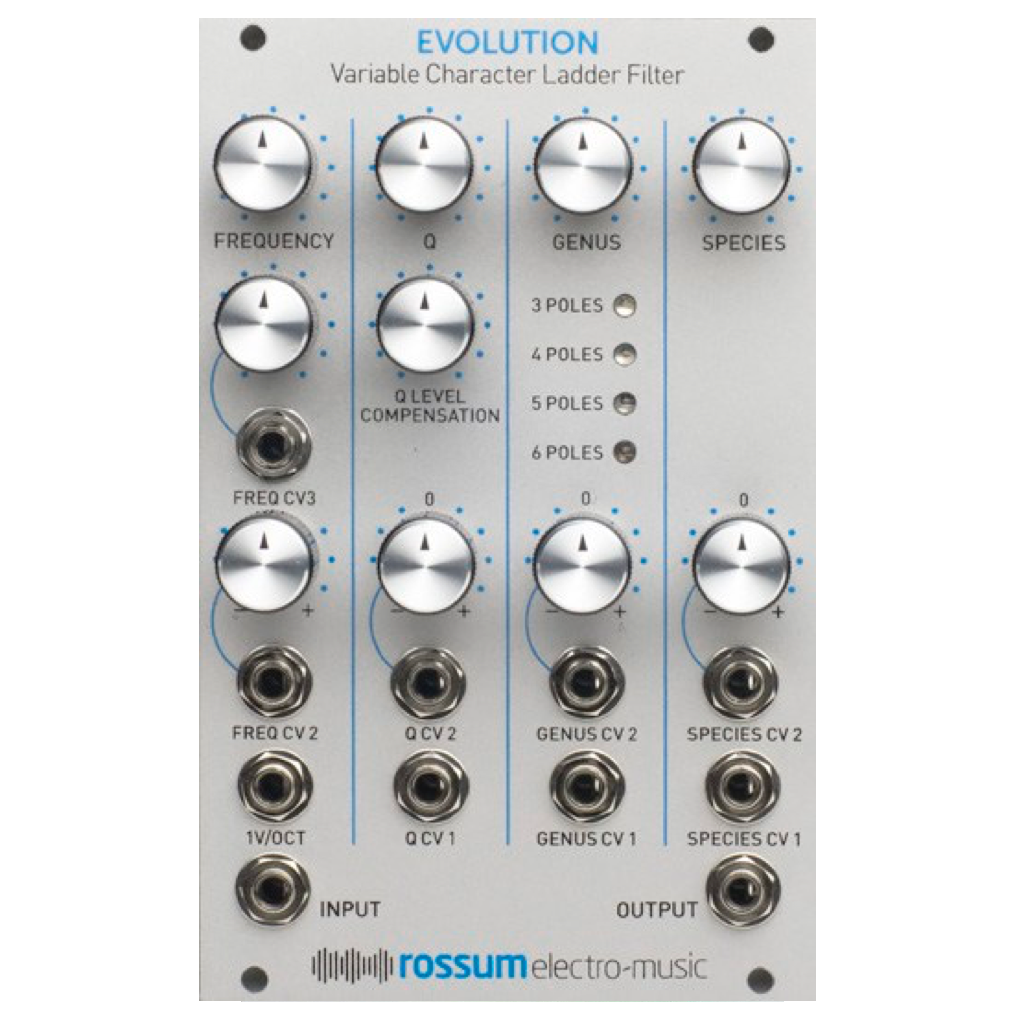
Evolution
Rossum Electro-Music
Regular price
$3,920.00 HKD
Sale
At the core of the EVOLUTION Variable Character Ladder Filter is Dave Rossum’s enhancement of the iconic Moog ladder filter from the original E-mu Systems 2100 LPF module (which, incidentally, Dave counts as his favorite sounding of all of the analog filters he designed).
For EVOLUTION, Dave has designed new capabilities that not only allow you to dial in all of the outstanding qualities of the original 2100, but combine to let you create the sonic characteristics of a wide variety of other filter types.
They include:
- A Genus control that allows continuous voltage control of the number of filter poles (from 3 to 6 poles), essentially allowing real-time variation of Evolution’s effective cutoff slope from 18dB/oct to 36dB/oct. LEDs give continuous indication of the current slope.
- A Species control that lets you vary the signal level into the ladder, letting you control the intensity of the filter’s characteristic distortion. When in self-oscillation mode, this control modulates the amplitude of Evolution’s output.
- Voltage controlled resonance with a variable Q Level Compensation control that controls the balance of the resonant peak and the frequencies below the cutoff frequency (which would otherwise be attenuated as the resonance is increased).
- An extremely accurate and temperature-stable frequency control exponential generator (accurate over 10 octaves), rivaling the specifications of the best analog VCOs.
Taken together, EVOLUTION gives you everything from the platonic ideal of the classic ladder filter to a vast selection of alternative filter characteristics.
And like all Rossum Electro-Music modules, it’s solidly built, with machined aluminum knobs and high quality components throughout.
To learn a lot more about the evolution of EVOLUTION, check out this post from Dave’s lab.
Evolution Specifications
Controls
Initial Frequency
Initial Q
Q Level Compensation
Initial Genus (# of Poles)
Initial Species (Ladder Input Level)
Signal Input
1x 3.5 mm mono socket – 100 kΩ Input Impedance
Signal Output
1x 3.5 mm mono socket – 1 kΩ Output Impedance
Frequency CV Inputs
1x Attenuated – min 50 kΩ Input Impedance
1x w/Attenuverter – 100 kΩ Input Impedance
1x 1V/OCT Full Level – 100 kΩ Input Impedance
Q CV Inputs
1x Full Level – 100 kΩ Input Impedance
1x w/Attenuverter – 100 kΩ Input Impedance
Genus CV Inputs
1x Full Level – 100 kΩ Input Impedance
1x w/Attenuverter – 100 kΩ Input Impedance
Species CV Inputs
1x Full Level – 100 kΩ Input Impedance
1x w/Attenuverter – 100 kΩ Input Impedance
Power Requirements
+/-12 V via 16-pin, Doepfer-style connector
Current Draw
85 mA +12 V, 75 mA -12 V (maximum)
Dimensions
16HP (W); Rear of panel to top of power connector (with connector plugged in) 25 mm (D)
Supplied Accessories
1x 16-pin, Doepfer-style power cable
4x M3 screws
4x M2.5 screws
4x Nylon washers
1x Quickstart Guide
